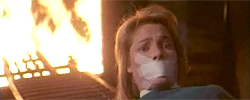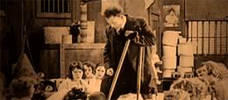Reviews
Make Them Die Slowly
Umberto Lenzi
Italy, 1981
Credits
Review by David Carter
Posted on 11 October 2007
Source Sazuma DVD
Related articles
Reviews Cannibal Holocaust
Reviews Emanuelle and the Last Cannibals
Reviews Chew on This
Categories 31 Days of Horror
The horror genre is, by its very nature, cannibalistic. Umberto Lenzi has repeatedly denied the connection between his Cannibal Ferox and Ruggero Deodato’s Cannibal Holocaust, but the two films essentially pose the same conclusions, albeit using vastly different methods. Cannibal Holocaust blurred the lines between an art film and a horror film; Cannibal Ferox never positions itself as anything but a pure horror film, and a considerably effective one at that.
Gloria, Rudy, and Pat have journeyed into the heart of the Amazon in hopes of finding proof of Gloria’s doctoral thesis: she is convinced that cannibalism is nothing more than a racist myth perpetrated by colonial powers to demonize indigenous peoples. Pat was expecting more of a relaxing vacation, but she abandons all hope of rest when the trio makes their first foray into the dense jungle. Meanwhile, back in New York City, Lt. Rizzo is searching for a small time drug dealer named Mike Logan who may have been involved in a murder. When Rudy gets the jeep stuck in a mud hole, who should stumble out of the jungle but the same Mike Logan, dragging his wounded friend Joe alongside.
Mike tells of how he, Joe, and another companion had been savagely attacked by a cannibal tribe. Gloria is understandably shocked by this and begins to question the validity of her thesis. The group decides to make their way out of the jungle as soon as possible, but Joe’s condition forces them to take refuge in an almost abandoned village, the same where Mike claimed to have been attacked. With his dying breaths, Joe confesses to Gloria and Rudy the truth about their situation: Mike, crazed from excessive cocaine use, tortured and murdered a native boy in this village. The revelation explains the natives’ fear of the white people, and promises vengeance will soon follow. As expected, the returning villagers capture the foursome, and subsequently take great pride in their methodical and agonizing torture of Mike before turning their attention to the remainder.
Cannibal Ferox is comprised of several familiar horror tropes. To wit, there is the tried and true “they should have known better” aspect. Just as a well-versed horror audience knows that when you go exploring an abandoned house after dark something bad will inevitably happen, those enjoying Cannibal Ferox should immediately recognize Mike Logan’s liability as a traveling companion. Gloria may be working on her PhD in anthropology, but she’s a poor judge of character. As in Cannibal Holocaust, we have the question of “who is more civilized,” but here, rather than critiquing the whole of society, Lenzi places the onus on Mike.
It is Mike who first introduces the film’s horror through his cocaine-fueled torture of the native boy. And unlike the nihilistic violence of Holocaust, Ferox goes about its mayhem with the same joyous abandon as Mike. Nothing is implied in this film, each gory dismemberment shown in excruciating detail. In a particularly nasty (and effective) instance, Lenzi teases with several quick cutaways during Mike’s violence upon one of the natives. Wrongly believing that we will be spared the sight of the violence, the bloody act is finally shown, and is far more lucid than anticipated.
In keeping with both Cannibal Holocaust and classic horror, Cannibal Ferox’s victims become demonized. This applies primarily to Mike and Pat, whose respective castration/decapitation and breast impalement are the film’s most notorious scenes. Though tortured in horrific ways by the cannibals, the film goes out of its way to articulate the idea that their torture is entirely deserved. Mike in particular suffers an ironic fate given his previous actions, a death not unlike one would expect in an EC horror comic of the fifties. In the case of Pat it’s more guilt by association than anything more substantive. She dimwittedly follows Mike’s lead but doesn’t instigate the violence herself—perhaps this is Lenzi’s subtle way of demeaning those with even passive involvement in such acts.
The several messages of Cannibal Holocaust demand multiple viewings and careful consideration. On the other hand, Cannibal Ferox wastes little time with artistry, opting instead to make its intentions clear to the viewer from the outset. The film’s bluntness should not be mistaken for a lack in quality; Cannibal Ferox’s simplicity is its strength, with Lenzi constantly reiterating the film’s critique of society in each scene. And ultimately the viewer, like the unfortunate victims, is given no opportunity to escape from the onslaught.
More 31 Days of Horror
-

Alien
1979 -

The Elephant Man
1980 -

My Bloody Valentine
1981 -

Who Can Kill a Child?
1976 -

Cannibal Holocaust
1980 -

Let Sleeping Corpses Lie
1974 -

John Carpenter’s Vampires
1998 -

Jaws 2
1978 -

A Warning to the Curious
1972 -

Wolf
1994 -

The Survivor
1981 -

Cannibal Ferox
1981 -

The Nights of Terror
1981 -

Death Becomes Her
1992 -

Alice, Sweet Alice
1976 -

Body Double
1984 -

Invocation of My Demon Brother
1969 -

Phantasm II
1988 -

Emanuelle and the Last Cannibals
1977 -

The Wicker Man
1973 -

Maniac Cop
1988 -

The Legend of the 7 Golden Vampires
1974 -

The Penalty
1920 -

Boxing Helena
1993 -

Chew on This
2005 -

Night of the Creeps
1986 -

Night of the Lepus
1972 -

Near Dark
1987 -

Army of Darkness
1992 -

The Brood
1979 -

The Lift
1983 -

Amsterdamned
1988 -

Silent Witness
1999 -

The Shaft
2001
We don’t do comments anymore, but you may contact us here or find us on Twitter or Facebook.



